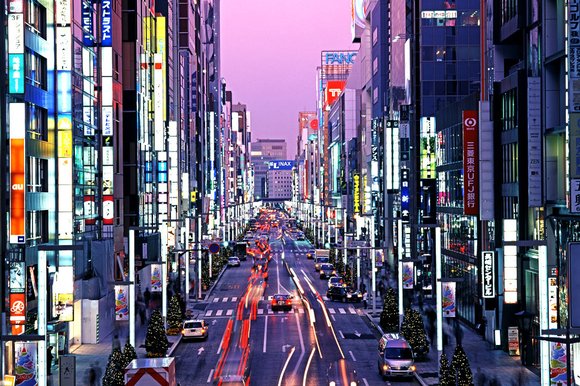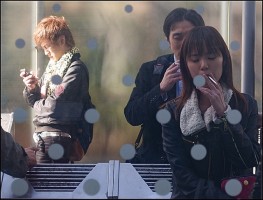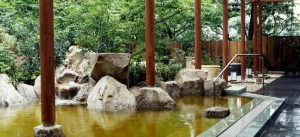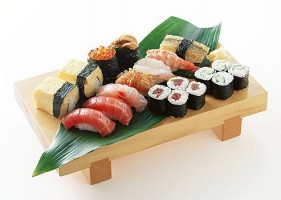Don’t tip
Attentive service is the norm in Tokyo, a piece of a cultural dedication to hospitality known as omotenashi. You don’t need to tip in taxis, at hair salons, for bartenders or doormen. Not only are gratuities not allowed, they won’t be accepted. Some restaurant bills will include a service charge. In case you leave money behind, no matter how much or little, be ready to be chased by your server down the street to turn it back.Walk right on the left
Tokyo is one of the most densely populated urban cities in the world. Around 35 million people live here, so crowds are common. Everybody waits until the light allows crossing the street. Pedestrians on wide sidewalks require staying to the left almost as strictly as cars do. Exception: You have to stand on the left but walk on the right on Tokyo escalators.
The more enclosed a space is, the more likely you can smoke there. The smaller and homier a restaurant or a bar, the more likely you’ll be allowed to smoke. Lots of bullet trains still have smoking cars. On the other hand, you cannot smoke on many sidewalks (put your attention to the signs stenciled on the sidewalk), except around public ashtrays. Street patrols detect persons who engage in aruki-tabako meaning ‘walking-smoking.’ However, cracking open a beer or can of chu-hai on the walk or train home is an old tradition.
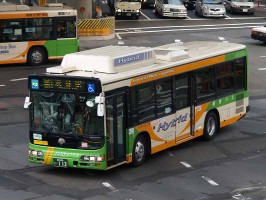 One card for all buses and trains
One card for all buses and trains
There is a network of three train companies in Tokyo train system. Earlier, each system required its own tickets. Nowadays rechargeable Pasmo and Suica cards let passengers seamlessly go their way in and out of all lines. As of March 2013, paying fares became even simpler – a single card usable for buses and trains throughout the country. It’s possible to get one as soon as you get in Tokyo from almost any ticket machine. The ¥500 charge for the card is refundable (a bit more than $5). The time you save not including ticket costs makes it worthwhile even in case you keep the card as a souvenir.
 There are pockets of quiet on every step
There are pockets of quiet on every step
Starting with the temples hidden between office buildings (HanazonoShrine in Shinjuku is a famous of these) and finishing with the tree-lined canal that runs the length of Nakameguro, you are never far from a pocket of calm in the huge city. Winding residential streets lined with gardens are frequently just a block away from main roads. If you take a detour down unmarked road (the majority of Japanese streets have no names) chances are you’ll find a tiny café, quirky neighborhood art project or a jumble of contemporary condos and rickety ancient architecture.
Public bathhouses (sento) are a soothing holdover from a time when the majority of homes didn’t have bathtubs. No matter if it’s bright, contemporary place in Omotesando with fizzy wate and fancy soap or a creaky neighborhood bath with a coin-operated hairdryer that’s been bolted to the floor since 1960, all of them cost ¥450. The Tokyo Sento Association is putting efforts to make public baths foreigner friendly ahead of the Olympics by posting etiquette and instruction cards translated in 4 languages.
‘Welcome’ word you hear everywhere
After several days in Tokyo, you might find yourself asking, “What’s that word they always say when I come in?” No matter if it’s sweaty, aproned men shouting in unison as you enter lively restaurants that serve alcohol with various small dishes or one perfectly coiffed girl whispering as you walk in the hush of a small boutique, they are saying the same word: “Irasshaimase.” It’s a polite way to say “welcome.” Although your intention may be to answer – “Thank you!” or “Hello” – locals say no response is required. A friendly little bow in response is okay, though.
The popular tuna auction at Tsukiji market takes place after 5 a.m., but the day’s 120 free tickets are frequently all snapped up as early as 4. No matter if you get to auction or not, the market and surrounding shops will be open around that time – it’s the best place to enjoy an early morning place of the freshest sushi you’ve ever eaten. You mustn’t be there that early, but lots of the hundreds of shops start to close by 1 p.m. Try and you too will be one of those tourists who cannot eat sushi back home without mentioning, ‘It’s good, but it’s nothing like the maguro I tasted in Tokyo.’
Free WiFi is rare
While the amount of places that have free WiFi in Japan is increasing, access isn’t what you can count on. Signs everwhere promising free WiFi in case you already have a contract with the provider. Even places like Starbucks that have accessible free WiFi require you to create an account first. Instead of renting a SIM card, lots of tourists discover that renting a pocket WiFi at the airport to use with their own smartphones is the best way to get online.
Bacon turns up everywhere
Japan is a country with a long tradition of Buddhist vegetarian cuisine known as shojinryori. It’s painstakingly prepared and served on ceramics and lacquerware. It’s worth experiencing and guaranteed to be vegetarian but it’s expensive and a time-consuming deal. For a fast vegetarian meal, you usually have to be vigilant. A ‘vegetable sandwich’ may have a sneaky slice of ham inside, and pasta with no meat could be studded with chunks of bacon. This is because ‘meat’ stands for ‘beef.’ Running down a list of every animal product you’d like to avoid is the only possible way to be sure. And your potato salad might still include bacon.
If you are in Tokyo when it’s starts raining, lucky you – it’s a perfect chance to pick up a clear umbrella. It’s such a simple innovation, you wonder why they haven’t caught on everywhere. As the first drops of rain fall, you’ll find them everywhere. Convenience stores will put their stock by the door. One umbrella costs from ¥300 to ¥500. The clerk will suggest to unwrap it for you if you’re using it right away. But keep in mind that umbrellas are the one item that’s often stolen in Tokyo.

